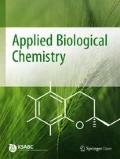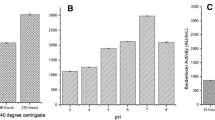Abstract
Present study was conducted to optimize avermectin B1b production from S.avermitilis 41445 UV45(m)3 using artificial neural network and response surface methodology. Three variables NaCl, KCl, and pH were used for optimization. Coefficient of determination and adjusted coefficient of determination have very poor values for RSM. Values predicted by RSM for experiments were also much different from the observed avermectin production. Comparatively predicted avermectin levels by ANN were very close to observed values with much higher R2 and adjusted R2. Optimum levels of NaCl, KCl, and pH predicted by ANN were 1.0 g/L, 0.5 g/L, and 7.46 respectively. Sensitivity analysis predicted highest effect being shown was by pH followed by NaCl and KCl. About 37.89 folds increase in avermectin B1b production was observed at optimum levels of three variables envisage by ANN. Optimum levels, ranking order of variables, and the predicted avermectin on the optimum levels by the RSM was much different from ANN values. Results revealed that ANN is a better optimization tool for given strain than RSM.
Similar content being viewed by others
References
Azaman S, Ramakrishnan N, Tan J, Rahim R, Abdullah M, and Ariff A (2010) Optimization of an induction strategy for improving interferonalpha2b production in the periplasm of Escherichia coli using response surface methodology. Biotech Appl Biochem 56, 141–150.
Baoxin Z, Xiangjing W, and Wensheng W (2011) Optimization of fermentation medium for enhanced production of milbemycin by a mutant of Streptomyces bingchenggensis BC-X-1 using response surface methodology. African J Biotechnology 10(37), 7225–7235.
Bas D and Boyaci IH (2007) Modeling and optimization I: Usability of response surface methodology. J Food Eng 78, 836–845.
Bezerra MA, Santelli RE, Oliveira EP, Villar LS, and Escaleira LAI (2008) Response surface methodology (RSM) as a tool for optimization in analytical chemistry. Talanta 76, 965–977.
Burg RW, Miller BM, Baker EE, Birnbaum J, Currie SA, Hartman R et al. (1979) Avermectins, new family of potent anthelmintic agents: producing organism and fermentation. Antimicrobial agents Chemother 15, 361–367.
Chen HL, Yao J, Wang L, Wang F, Bramanti E, Maskow T et al. (2009a) Evaluation of solvent tolerance of microorganisms by microcalorimetry. Chemosphere 74, 1407–1411.
Chen XC, Bai JX, Cao JM, Li ZJ, Xiong J, Zhang L et al. (2009b) Medium optimization for the production of cyclic adenosine 3,5-monophosphate by Microbacterium sp. no. 205 using response surface methodology. Bioresource tech 100, 919–924.
Chen Z, Wen J, Song Y, Wen Y, and Li J (2007) Enhancement and selective production of avermectin B by recombinants of Streptomyces avermitilis via intraspecific protoplast fusion. Chinese Sci Bulletin 52, 616–622.
Dasari VRRK, Donthireddy SRR, Nikku MY, and Garapati HR (2009) Optimization of medium constituents for cephalosporin C production using response surface methodology and artificial neural networks. J Biochem Techn 1, 69–74.
da Silva I, Martins M, Carvalho C, de Azevedo J, and de Lima Procópio R (2012) The Effect of Varying Culture Conditions on the Production of Antibiotics by Streptomyces spp. iIsolated from the Amazonian Soil. Ferment Techno 1(3).
Deepak V, Kalishwaralal K, Ramkumarpandian S, Babu SV, Senthilkumar S, and Sangiliyandi G (2008) Optimization of media composition for Nattokinase production by Bacillus subtilis using response surface methodology. Bioresource tech 99, 8170–8174.
Dey G, Mitra A, Banerjee R, and Maiti B (2001) Enhanced production of amylase by optimization of nutritional constituents using response surface methodology. J Biochem Eng 7, 227–231.
Dutta JR, Dutta PK, and Banerjee R (2004) Optimization of culture parameters for extracellular protease production from a newly isolated Pseudomonas sp. using response surface and artificial neural network models. Process Biochemistry 39, 2193–2198.
Elibol M (2004) Optimization of medium composition for actinorhodin production by Streptomyces coelicolor A3 (2) with response surface methodology. Process Biochemistry 39, 1057–1062.
Gao B, Su E, Lin J, Jiang Z, Ma Y, and Wei D (2009) Development of recombinant Escherichia coli whole-cell biocatalyst expressing a novel alkaline lipase-coding gene from Proteus sp. for biodiesel production. J Biotech 139, 169–175.
Guo Z, Shen L, Ji Z, and Wu W (2012) Enhanced production of a novel cyclic hexapeptide antibiotic (NW-G01) by Streptomyces alboflavus 313 using response surface methodology. Int J Mol Sci 13, 5230–5241.
Hamsaveni D, Prapulla S, and Divakar S (2001) Response surface methodological approach for the synthesis of isobutyl isobutyrate. Process Biochemistry 36, 1103–1109.
Hill T and Lewicki P (2006) In Statistics: Methods and applications: A comprehensive reference for science, industry, and data mining: StatSoft, Inc., Southern Africa.
Hornik K, Stinchcombe M, and White H (1989) Multilayer feedforward networks are universal approximators. Neural networks 2, 359–366.
Hounsa C, Aubry J, Dubourguier H, and Hornez J (1996) Application of factorial and Doehlert designs for optimization of pectate lyase production by a recombinant Escherichia coli. J Appl Microbio Biotechn 45, 764–770.
Huang J, Lu C, Qian X, Huang Y, Zheng Z, and Shen Y (2011) Effect of salinity on the growth, biological activity and secondary metabolites of some marine fungi. Acta Oceanologica Sinica 30, 118–123.
Ikeda H and Omura S (1997) Avermectin biosynthesis. Chem Rev 97, 2591–2609.
James P, Edwards C, and Dawson M (1991) The effects of temperature, pH and growth rate on secondary metabolism in Streptomyces thermoviolaceus grown in a chemostat. J General Micro 137, 1715–1720.
Jayati RD, Pranab KD, and Rintu B (2004) Optimization of culture parameters for extra cellular protease production from a newly isolated Pseudomonos sp. under response surface methodology and artificial neural network models. Process Biochem 39, 2193–2198.
Jo JH, Lee DS, Park D, Choe WS, and Park JM (2008) Optimization of key process variables for enhanced hydrogen production by Enterobacter aerogenes using statistical methods. BioResource Technology 99, 2061–2066.
Lee CL and Wang WL (1997) Biological Statistics, Science Press, China.
Liang JG, Chu XH, Chu J, Wang YH, Zhuang YP, and Zhang SL (2010) Oxygen uptake rate (OUR) control strategy for improving avermectin B1a production during fed-batch fermentation on industrial scale (150 m 3). Afr J Biotechnol 9, 7186–7191.
Li XY, Liu ZQ, and Chi ZM (2008a) Production of phytase by a marine yeast Kodamaea ohmeri BG3 in an oat medium: optimization by response surface methodology. BioResource Technology 99, 6386–6390.
Li Y, Jiang H, Xu Y, and Zhang X (2008b) Optimization of nutrient components for enhanced phenazine-1-carboxylic acid production by gacA-inactivated Pseudomonas sp. M18G using response surface method. J Appl Microbio Biotech 77, 1207–1217.
Lin X, Wen Y, Li M, Chen Z, Guo J, and Song Y (2009) A new strain of Streptomyces avermitilis produces high yield of oligomycin A with potent anti-tumor activity on human cancer cell lines in vitro. J. Appli Microbio Biotech 81, 839–845.
Liu GQ and Wang XL (2007) Optimization of critical medium components using response surface methodology for biomass and extracellular polysaccharide production by Agaricus blazei. J Appl Microbio Biotech 74, 78–83.
Lou W and Nakai S (2001) Application of artificial neural networks for predicting the thermal inactivation of bacteria: a combined effect of temperature, pH and water activity. J. Food Res Int 34, 573–579.
Nagata Y and Chu KH (2003) Optimization of a fermentation medium using neural networks and genetic algorithms. Biotechnology Letters 25, 1837–1842.
Nelofer R, Ramanan R, Rahman R, Basri M, and Ariff A (2011) Sequential optimization of production of a thermostable and organic solvent tolerant lipase by recombinant Escherichia coli. Annals of Microbiology 61, 535–544.
Nelofer R, Ramanan RN, Rahman RNZRA, Basri M, and Ariff AB (2012) Comparison of the estimation capabilities of response surface methodology and artificial neural network for the optimization of recombinant lipase production by E. coli BL21. J Indust Microbio Biotech 39, 243–254.
Noorossana R, Davanloo Tajbakhsh S, and Saghaei A (2009) An artificial neural network approach to multiple-response optimization. Inter J Adva Manufac Tech 40, 1227–1238.
Rao KJ, Kim CH, and Rhee SK (2000) Statistical optimization of medium for the production of recombinant hirudin from Saccharomyces cerevisiae using response surface methodology. Process Biochemistry 35, 639–647.
Rezanka T and Votruba J (1998) Effect of salinity on the formation of avermectins, odor compounds and fatty acids by Streptomyces avermitilis. Folia Microbiologica 43, 47–50.
Rusli FM, Ramanan RNZRA, Mohamad R, Puspaningsih NNT, and Ariff AB (2010) Enhanced production of xylanase by recombinant Escherichia coli DH5 through optimization of medium composition using response surface methodology. Annals of Microbiology 60, 279–285.
Sayyad SA, Panda BP, Javed S, and Ali M (2007) Optimization of nutrient parameters for lovastatin production by Monascus purpureus MTCC 369 under submerged fermentation using response surface methodology. Applied Microbiology and Biotechnology 73, 1054–1058.
Song Y, Li Q, Zhao X, Sun Y, and Liu D (2012) production of 2.3-Butanediol by Klesbsiella pneumoniae from enzymatic hydrolyzate of sugarcane bagasse. BioResources 7(4), 4517–4530.
Sood M (2011) Effect of Tempeature of Incubation on the Growth, Sporulation and Secondary Metabolites Production of Aspergillus umbrosus. J Phyto 3, 35–27.
Wang Y, Lu Z, Sun K, and Zhu W (2011) Effects of high salt stress on secondary metabolite production in the marine-derived fungus Spicaria elegans. Marine drugs 9, 535–542.
Xiong ZQ, Tu XR, and Tu GQ (2008) Optimization of medium composition for actinomycin X2 production by Streptomyces spp JAU4234 using response surface methodology. J Indus Micro Biotech 35, 729–734.
Yong J and Byeon W (2005) Alternative production of avermectin components in Streptomyces avermitilis by gene replacement. J Microbio 43, 277–284.
Zheng ZM, Hu QL, Hao J, Xu F, Guo NN, Sun Y et al. (2008) Statistical optimization of culture conditions for 1,3-propanediol by Klebsiella pneumoniae AC 15 via central composite design. BioResource Technology. 99(5), 1052–1056.
Author information
Authors and Affiliations
Corresponding author
Rights and permissions
About this article
Cite this article
Siddique, S., Syed, Q., Nelofer, R. et al. Avermectin B1b production optimization from Streptomyces avermitilis 41445 UV 45(m)3 using response surface methodology and artificial neural network. J Korean Soc Appl Biol Chem 57, 371–378 (2014). https://doi.org/10.1007/s13765-013-4172-8
Received:
Accepted:
Published:
Issue Date:
DOI: https://doi.org/10.1007/s13765-013-4172-8




